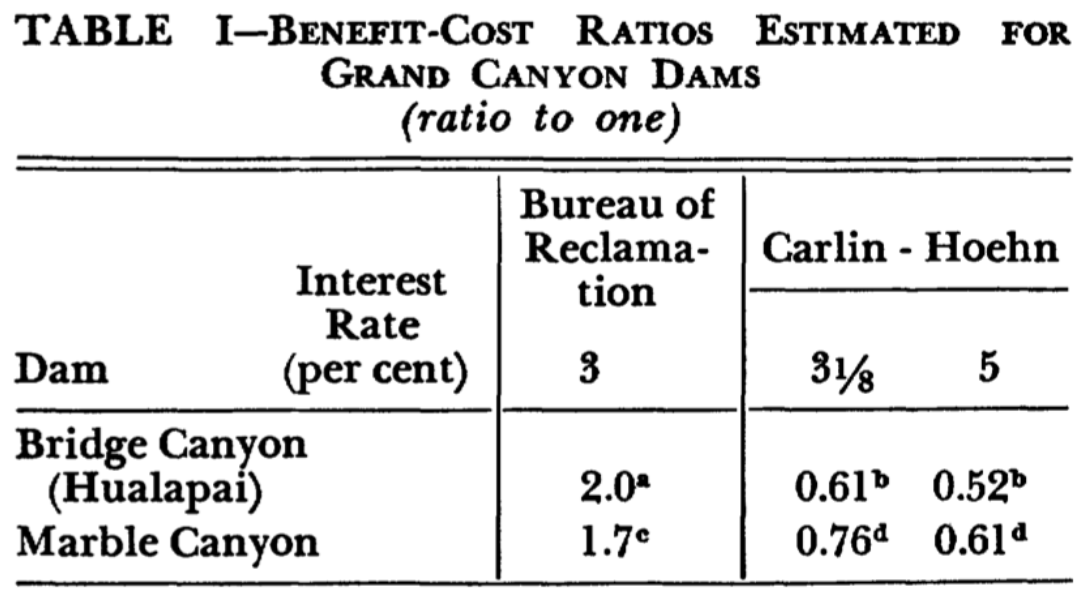In her enlightening presentation on the value of Glen Canyon Dam, Kate Wilkins (2017) weighed the benefits and costs of the dam and discussed the challenges of implementing an alternative regulation. Kate’s presentation began with a discussion of the social and political setting in which Glen Canyon Dam was built. She explained that just before Glen Canyon Dam was proposed in the 1950s, there were two other proposed dams along the Colorado River that were ultimately abandoned. At the time, these two dams—the Marble Canyon Dam and the Bridge Canyon Dam—created a large controversy over the true costs and benefits of building dams.
The controversy over these dams immediately peaked my attention, because, as Kate explained, it brought the methods of economic valuation to the public’s attention. When examining the efficacy of projects that may have ramifications for the environment, local communities, and society, economists usually condense their complicated analyses into a single number: the benefit-cost ratio. The incredible usefulness of the benefit-cost ratio is due to its ease of interpretability; if the ratio is greater than one, then benefits outweigh the costs, which makes a compelling case for implementing the project. While the final benefit-cost ratio is simplistic, the analysis that generates the ratio is just the opposite. Benefit-cost analyses are incredibly complicated and involve many explicit and implicit assumptions. With regard to the Marble Canyon and Bridge Canyon Dams, the Bureau of Reclamation’s published benefit-cost ratios were challenged. This created the controversy over the two dams and brought the methodology behind these ratios to the public’s attention.
Table 1 below illustrates the substantial differences between the Bureau of Reclamation’s findings and the later findings of two other researchers. Carlin and Hoehn (1967) found that the costs for both dams were almost double the benefits, while the Bureau of Reclamation found the opposite—benefits were estimated as twice the size of costs.

Carlin (1968) attributes the differences in these ratio estimates to four “questionable procedures” that the Bureau followed. First, the Bureau defined the opportunity cost of building the dams using the “most likely alternative” rather than the least costly alternative. To state this simply, the Bureau used an opportunity cost that was lower than actuality; this artificially increased the benefit-cost ratio.
Second, the Bureau used higher interest rates and taxes when evaluating the alternatives than when evaluating the dams. This again contributed to understating the opportunity costs of the dam, and further boosted the estimated benefits for the dam. Interest rates are a vital component of cost-benefit analyses, and are frequently a source of contention due to the inherent subjectivism in choosing the rate. However, utilizing different interest rates over the same time period for alternative options is objectively incorrect. Third, and related, the interest rates the Bureau used were below current and projected costs of borrowing. By not accurately depicting the present cost of long-term government borrowing, these low interest rates, again, understated the costs of the dams.
Fourth, the Bureau restricted alternative options so that any considered power provider would distribute energy to exactly the same customers as the dams. By imposing this restriction, the Bureau did not evaluate the alternative options at their optimal usage. Therefore, this restriction, again, undervalued the true benefits from the alternative options, which caused the Bureau to underestimate the opportunity cost to the dams, and contributed to their alarmingly high benefit-cost ratios.
Carlin (1968) brought the nuances behind these benefit-cost ratios into the public eye and ultimately the Marble Canyon and Bridge Canyon Dams were never realized. This was the political and social economy in which the Glen Canyon Dam was proposed, but despite facing a public that was increasingly skeptical of the Bureau’s analyses, the Glen Canyon Dam was built. Now, as Kate Wilkins did in her magnificent presentation, we can consider whether the estimated benefit-cost ratios for the Glen Canyon Dam were accurate.
In her presentation, Kate outlined four major benefits to the Glen Canyon Dam: water storage, water use, hydroelectric power, tourism, and recreation. Glen Canyon Dam has created 26.2 million acre feet of water storage area, which is primarily used for irrigating pasture and cropland. Additionally, the Dam is the second-largest producer of hydroelectric power in the Southwestern United States, raking in $153 million annually from electric energy sales. Finally, Glen Canyon Dam has many benefits for visitors to Lake Mead and the Grand Canyon, but it’s difficult to assign a monetary value to this benefit. Economists tend to use Travel Cost or Contingent valuation for assigning benefits from recreation, but both methods involve significant assumptions and more data than is available.
Kate also outline four major costs to the Glen Canyon Dam: tourism and recreation, operations and maintenance, ecological and cultural, and non-use value. Of these costs, the only ones that are easily measurable are from operations and maintenance, but even this is hard to find adequate data to asses.
Last year Glen Canyon Dam celebrated its 50th birthday; even with 50 years of data, we still cannot depict an accurate benefit-cost ratio of the project. Perhaps these ratios are not as definitive as economists would lead us to believe.
Resources:
Carlin, A. (1968) “The Grand Canyon Controversy: Lessons for Federal Cost-Benefit Practices.”
Land Economics. 44(2): 219-227.
Carlin, A. and W. Hoehn. (1967) “The Grand Canyon Controversy—1967: Further Economic Comparisons of Nuclear Alternatives.” Santa Monica, CA: RAND Corporation.
Wilkins, K. (2017) “The Value of Glen Canyon Dam.” Presentation for the Grand Canyon Seminar, 22 Feb 2017. Davis, CA.
